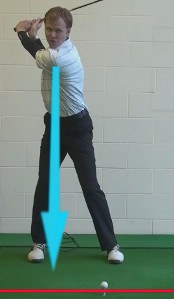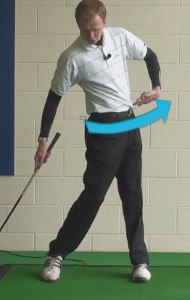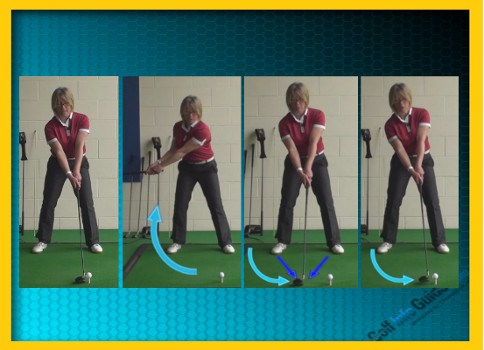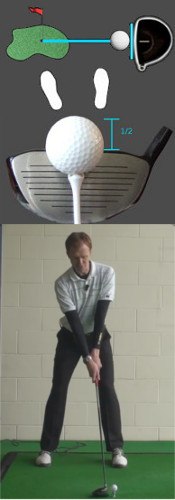
So you want to hit the ball farther, but you don't want to sacrifice accuracy in the process. You know that most of professional golf's longest hitters rank low in fairway percentage, and that baseball's sluggers strike out a lot more often than they belt home runs. It would seem that distance and accuracy are mutually exclusive, begging the question:
Is it possible to add power without giving up precision?
Yes, it is. In fact, many power-boosting moves can actually help you hit the ball straighter. How can that be? Because generating maximum clubhead speed requires using your body's big and small muscles in unison, which is also the key to delivering the clubface squarely to the ball. The idea is to increase clubhead speed without merely swinging harder. In fact, proper mechanics allow you to produce more force with less effort.
These tips and drills will increase your clubhead speed and your accuracy:
- Max out that shoulder turn: Ideally, the shoulders should reach a 90° angle to the target line at the top of the backswing. Here's a drill to improve your rotation (no ball required):
- 1. With the driver, take your stance with the insides of your feet directly beneath the outsides of your shoulders.
- 2. Keep both your feet planted on the ground, from heel to toe, while swinging to the top.
- 3. Try to turn until your back faces the target. You'll feel stretching in the lower back and torso.
- 4. Finish the swing.
- Transfer your weight correctly: Reaching the proper backswing position is half the battle. The second half is getting the weight from your right side back to the left on the downswing and follow-through. Gary Player's classic walk-through drill
- Hips lead the downswing: Again, achieving a great backswing turn isn't the be-all, end-all. The downswing must begin with the left heel pressing into the ground, which activates the left knee and hip to rotate toward the target. The torso and shoulders follow in sequence, pulling the arms into a power position.

By the way: While golf's bombers may miss a lot of fairways compared with their shorter-hitting peers, they still manage to find upward of 60% of fairways at clubhead speeds of 120 mph or more – proof that you can hit it long and straight.

Drive It Both Long and Straight – Yes You Can!
It seems that many golfers view their driving as an either-or proposition. They think that they can only have one half of the long and straight equation. Some players decide to hit the ball as far as they can, regardless of where it is going to go. On the other hand, some players opt to play a control game, intentionally giving away distance in favor of more accurate shots. There are arguments to be made in favor of both options, but a third option is really where you want to wind up – with a driving game that includes both distance and accuracy.
If you need proof that it is possible to hit the ball both long and straight, you need look no further than the PGA Tour. The players are the top of the game regularly blast long drives right down the middle of the fairway. Sure, some of those players are more accurate than others, but they all are capable of producing plenty of power while still keeping the ball in the short grass. While you might not wind up with the kind of power or control in your game that is seen on the pro circuit, you can still strive to improve your performance in both of these areas.
In this article, we are going to offer advice on how you can add distance to your drives while improving your accuracy at the same time. Believe it or not, this task is not going to be quite as difficult as it sounds at first. In fact, many of the steps you can take will actually serve both of these goals. Most of the basic fundamentals in golf will help you to both generate more power and control your ball flight more consistently. There really isn't anything too tricky in this article – most of it comes down to basic golf instruction. Take these tips to heart and there is a good chance that your game will shortly become more powerful and more controlled all at the same time.
The purpose of this article is to prove that you can have both of these important elements in your game simultaneously. However, it should be pointed out that accuracy is always preferred over distance if you have to pick one over the other. For instance, if you find that a certain technique you can add to your swing allows you to pick up several yards – but it makes it harder to hit fairways – you should leave that technique on the range. Golf is a control game first and foremost. Sure, it is helpful to hit your shots a long distance, but that distance will do you no good if you can't find the ball.
All of the content below is based on a right-handed golfer. If you happen to play left-handed, please take a moment to reverse the directions as necessary.

Three Key Building Blocks
If you hope to hit long and straight drives for many years to come, there are a few key fundamentals you need to have in place. Specifically, we are going to discuss three keys that should be considered essential for quality play off the tee. If you are missing even just one of these three, it will always be quite difficult to produce impressive tee shots.
- Balance. In golf, everything starts and ends with balance. If you are on balance, the game quickly becomes much easier. On the other hand, in your balance is poor, you will have trouble even making solid contact with the ball. No matter what kind of shot you are trying to hit, balance should always be your number one priority. As it relates to the topic at hand, balance is going to help you hit longer and straighter drives from a number of reasons. First, it will allow you to find the center of the club face more frequently. That means more of the energy from your swing will be transferred into the ball, and it means the ball will do a better job of holding its intended line. Also, you will be able to swing harder when you are balanced, since you won't be trying to prevent yourself from falling over along the way. Since it is important to have your balance in place on all shots, working on this skill with your drives is a great place to start. Not only will your drives be better for the effort, but the rest of your game should improve as well.
- Relaxed grip pressure. This is easily the most-overlooked fundamental in golf. Most players would list many other points before they got around to talking about grip pressure, but it is actually a key ingredient in your overall game. The average amateur golfer holds on to the club far too tightly. With a tight grip, you will be taking speed out of your swing unnecessarily. All you need to do is hold on to the club tight enough to make sure that it doesn't fly out of your hands – any more than that is just a waste, and it will interfere with your ability to swing freely through impact. To work on your grip pressure, start by hitting some easy chip shots with a light grip. As you gain comfort, gradually work your way up to hit longer and longer shots while your grip remains relaxed. It may take a little bit of time to adjust to a lighter grip, but you will soon see how powerful this adjustment can be.
- Steady head. In some ways, this is a pretty boring golf tip. After all, it isn't very exciting to stand out on the range and work on keeping your head still. Despite that, this is a key that you need to consider carefully while working on your game. If you can keep your head still, you will be able to make better contact swing after swing than if you were to let it move up and down or side to side. Holding your head still typically benefits swing speed as well. One of the common ways for golfers to lose swing speed is to slide to the left in the downswing. This move gets in the way of good rotation, and it takes speed out of your swing through the hitting area. By keeping your head still, you can prevent that dreaded slide to the left. Your body will be free to rotate instead of sliding, and the club will be able to whip through impact at an impressive pace.
If you can build your swing on a platform made up of these three fundamentals, you will be in excellent shape moving forward. Sure, there is more to the game than just these points, but they are a great place to start. Not only will you have the capability for both power and accuracy, but you will also have the ability to play consistent golf from hole to hole and round to round. Spend some time during upcoming practice sessions working on these three keys and your game will be better for the effort.

Using the Right Driver
You should never make the mistake of thinking that you can buy a great golf game. Golf is an extremely difficult game to play, and you aren't going to perform at a high level simply by purchasing new clubs. With that said, you can give yourself a better chance at good play by having the right gear in your bag. In this case, that means using a driver which is perfectly suited to your swing.
When contemplating which driver you should be putting in your bag, your attention should turn first to the shaft of the club. Think of the shaft as the engine of the driver. Without the right engine, it won't matter what kind of swing you are able to make – your shots simply won't live up to their potential. Amateur golfers often use shafts which are too stiff for the swings they make. To make sure you have the right shaft flex in your driver, the best thing you can do is visit a local golf facility to go through the club fitting process. An experienced fitter will be able to measure your swing using a launch monitor before making recommendations based on the results.
It is worth mentioning that you don't have to purchase the most expensive club on the shelves in order to get great performance. Brand name drivers tend to be quite pricey, but the lesser-known names have plenty of offer as well. The most important thing here is a great fit. When your driver matches up perfectly with the dynamics of your swing, great things are possible.
Depending on how much golf you play, and how well you treat your clubs, you should get at least a couple seasons out of a new driver, if not more. You do need to pay attention to wear and tear, however, as the club will eventually stop providing you with as much spring as it offered when it was new. If the ball sounds differently than it used to when coming off the club, or if you notice visible signs of distress on the face, it may be time to shop for a new driver.
As you are thinking about your driver, take a moment to confirm that you have the right grip on the club. That certainly seems like a minor point, but the wrong grip really can stand in your way. Specifically, you want to be paying attention to the thickness of the grip. When a grip is too thick for your hands, it will be hard to release the club correctly through the hitting area. At the same time, a grip which is too thin is going to promote a premature release, which is no good either. Just as you need to get fitted for the shaft in your driver, you also need to make sure your grip is a good fit. To check, wrap your left hand around the grip as if you were preparing to hit a shot. When the grip is an appropriate size, your fingertips will just barely touch the pad of your palm around the back of the club. If there is a big gap in that space, the grip is too thick – if your fingertips are pressed into your palm, the grip is too thin. Fortunately, this is an easy fix, if there is a problem. A new grip should only cost a few dollars, and many golf shops will install them for free.
At the end of the day, your driver is not going to hit the shots for you. It is, however, going to allow the quality of your swing to be reflected in the kinds of shots you hit. With a well-fitted driver that suits your swing perfectly, all possible distance and accuracy will be transferred from your swing to the ball. Take some time in the near future to go through a club fitting process at your local golf facility. Once you have a properly fitting driver in your hands, you will be amazed at the difference.

The Mental Side
The most powerful tool you have at your disposal on the golf course is your mind. If you are able to think clearly as you play, you can give yourself a significant leg up on the competition. Unfortunately, most amateur golfers struggle with the mental side. Most players believe they need to make better swings to lower their scores, but it is really the game between the ears which needs the most work.
So how can your mental game help you to hit longer and more accurate drives? Consider the following points –
- Picking a specific target. This is one of the best things you can do when standing on the tee. If you are like most golfers, you probably just aim 'for the fairway' when hitting a driver. That is a good starting point, of course, but it isn't nearly specific enough to get the job done. Instead, you should be aiming for a small spot within the fairway that can focus your mind on making an accurate swing. Since most fairways are at least 25 – 30 yards wide, just aiming for the fairway doesn't give your mind anything specific to focus on during the swinging action. Try picking out a very specific spot in the fairway – using visual markers in the distance, such as trees, is a good plan – and then do your best to drive the ball at that target. This is a powerful technique, and one which will almost certainly lead to more hit fairways in your coming rounds.
- Trusting your swing. Confidence is hard to come by in golf. Assuming you are an amateur golfer, you probably don't have a deep trust in your ability to drive the ball consistently straight time after time. However, you are going to need to find a way to summon some confidence before you step up onto the tee with a driver. When you feel confident, you will be more willing to let it rip through the hitting area. And, of course, you are only going to reach your distance potential when you are willing to fire away without any concern for a wayward drive. To build up your confidence, pick specific targets on the driving range as you practice and keep track of how frequently you can hit your target. Most likely, you are more accurate than you believe. Seeing success on the range can help you to believe in yourself while on the course. It is amazing how far a little bit of trust can go when it comes to hitting long and straight drives.
- Accepting a few mistakes. You already know that golf is a hard game. In fact, that might even be one of the things which attracted you to this game in the first place. Some hobbies become boring over time as you master them, but that will never be a problem with golf. With such a difficult game, you have a lifetime full of challenge in front of you. To make sure you are able to hit long and accurate drives, you actually need to accept the fact that there are going to be a few bad ones along the way. Every golfer hits bad drives from time to time, so don't let a couple poor swings ruin your outlook on the performance of the driver. No golfer is perfect, so take the good with the bad and keep believing in yourself along the way.
You have to have your mind in the right place if you are going to hit long and straight drives more often than not. The three points above should help to put you in a good frame of mind while standing on the tee. One other point which should be mentioned has to do with your focus. Rather than chatting with your playing partners while getting ready to hit, focus in on the task at hand and pay attention to the swing. There will be plenty of time to talk later once your shot is safely in the fairway.

Some Final Thoughts
In this last section, we are going to get back to the physical characteristics of your swing. To make sure you are giving yourself the best possible chance to drive the ball long and straight, pay attention to the points below.
- Move your left shoulder under your chin. During the backswing, give yourself enough time to get your left shoulder all the way under your chin before you transition into the downswing. Or, at least, you should be getting as close to this position as your flexibility will allow. It is common for amateur golfers to cut their backswing short as they are in a rush to get the swing over with. Don't make that mistake. Give yourself plenty of time, turn your left shoulder under your chin, and give yourself the chance to develop impressive power thanks to this great turn.
- Stay down in your stance. This is another tip which is just as important with the rest of your clubs as it is with the driver. At address, you should have a comfortable degree of flex in your knees. When the swing begins, resist the temptation to give up some of that flex. Stay down, hold your position firmly, and use your flexed knees to support the rotation of your swing. The most likely point where you could lose your knee flex is at the top of the swing, so be sure to stay down through that transition and into the downswing. A stable lower body will give you the chance to swing through impact aggressively without falling off balance or losing track of the sweet spot on the driver.
- Swing all the way to a full finish. When your driver swing is complete, most of your weight should be on your left foot and your chest should be facing the target. It is common for amateur golfers to come up short of this position as they give up on the swing before it is actually over. Completing your swing is closely tied to your level of confidence. When you believe in yourself and your technique, you will be far more likely to commit all the way through impact and beyond.
It might seem like an impossible dream to hit drives which are both long and straight, but don't give up on the idea just yet. If you are willing to put in some time working on your game, you just might be able to add yards while also getting more accurate in the process. We hope the tips included in this article will help you to reach your goals with the driver as soon as possible. Of course, it is important to remember that golf is about more than the driver, so pay plenty of attention to the rest of your bag as well. Good luck!






